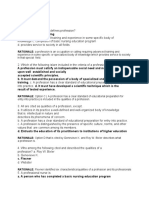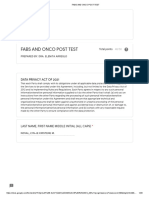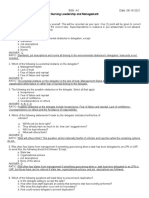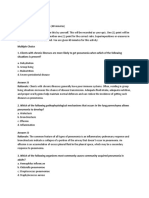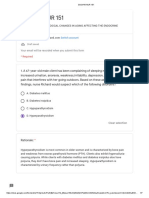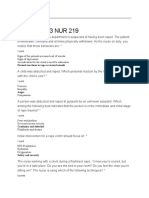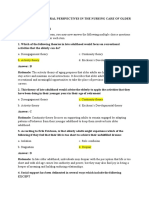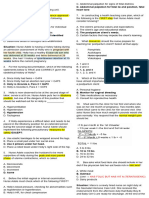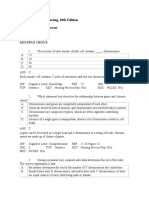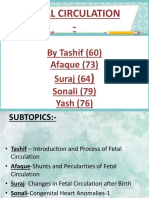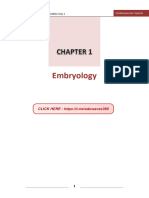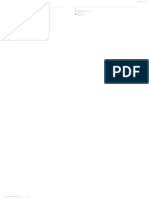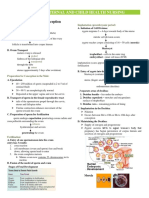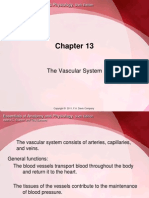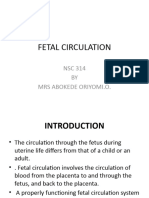SAS 1
1. Nurse Myra is teaching a prenatal class in Barangay Sinagtala, where she’s going over the
roles of the female reproductive system. Mrs. Thelma, a student in the class, inquiries about the
fallopian tubes' work. The nurse tells the client that:
a. The fallopian tubes secrete estrogen and progesterone.
b. The fallopian tubes are the passageway for the fetus
c. The fetus develops in the fallopian tubes
d. The fallopian tubes are where fertilization takes place.
ANSWER:
RATIO: Fallopian tube is the passage of ovum from ovary to the uterus and fertilization area.
2. When counseling an adolescent who has just started menstruating, which of the following
guidelines regarding behaviors during menstruation does the nurse include?
a. If menstrual discomfort continues, stay away from cold foods.
b. If menstrual pain persists, take a mild analgesic.
c. Stop exercising while you're on your period.
d. When menstruating, avoid sexual activity.
ANSWER:
RATIO: The nurse should instruct the client to take a mild analgesic, such as ibuprofen, if
menstrual pain or "cramps" are present. The client should also eat foods rich in iron and should
continue moderate exercise during menstruation, which increases abdominal tone. Avoiding
cold foods will not decrease dysmenorrhea. Sexual intercourse is not prohibited during
menstruation, but the male partner should wear a condom to prevent exposure to blood.
3. When a nurse working in a prenatal clinic looks at a client's chart, she notices that the doctor
has noted that the woman has a gynecoid pelvis. The nurse devises a treatment plan for this
client, knowing this form of pelvis:
a. is not favorable of labor
b. has a narrow pubic arc
c. is a wide pelvis with a short diameter
d. is the most favorable for labor and birth
ANSWER:
RATIO:
4. When the nurse tells a primigravid client that the placenta produces which of the following
hormones, she decides that the client requires further education.
a. Estrogen
b. Progesterone
c. Human chorionic gonadotropin (hCG).
d. Testosterone
ANSWER:
RATIO: During pregnancy, many hormone levels alter in the body, withseveral hormones
playing key roles. Human chorionic gonadotropinhormone (hCG) is a hormone that is only
created during pregnancy and isvirtually entirely synthesized in the placenta.
5. A nursing student is assigned to a client in labor. A nursing instructor asks the student to
describe fetal circulation specifically the ductus venosus. The nursing instructor determines that
the student understands fetal circulation if the student states that the ductus venosus:
a. Connects the pulmonary artery to the aorta
�b. is an opening between the right and left atria
c. connects the umbilical artery to the inferior vena cava
d. Connects the umbilical vein to the inferior vena cava
6. A physician has prescribed transvaginal ultrasonography for a woman in the first trimester of
pregnancy. The woman asks the nurse about the procedure. The nurse accurately provides
which of the following information to the client?
a. The procedure takes about 2 hours
b. Transmission gel is spread over the abdomen and a transducer will be moved over the
abdomen to obtain the picture
c. It will be necessary to drink 1 to 2 quarts of water prior to examination
d. The transvaginal probe encased in a disposable cover and coated with a gel is inserted into
the vagina.
ANSWER:
RATIO:
7. At 35 weeks of pregnancy, a multigravida client who works in a factory and stands for long
periods of time visits the prenatal clinic, saying, "The varicose veins in my legs have really been
bothering me lately." Which of the instructions below will be most useful?
a. "Twice a day, do gradual contractions and relaxations of the feet and ankles."
b. "Rest often with your legs elevated above your hips."
c. "Support hose that cross above the leg varicosities should be avoided."
d. "To prevent long periods of standing, take a leave of absence from your work"
ANSWER:
RATIO:
8. Which of the following suggestions would you make to a primigravid client suffering from leg
cramps at 37 weeks' gestation?
a. Throughout the day, change positions frequently.
b. Extend and flex the legs alternately.
c. Extend the toes toward the chin and straighten the leg.
d. In bed, lie prone with your legs raised.
ANSWER:
RATIO:
9. A nurse is reviewing a nutritional plan of care with a pregnant client and is identifying the food
items that are highest in folic acid. The nurse determines that the client understands which
foods supply the highest amounts of folic acid if the client states that she will include which of
the following in the daily diet?
a. a banana
b. leafy, green vegetables
c. Milk
d. yogurt
ANSWER:
RATIO
10. A pregnant client tells a nurse that she has been craving unusual foods. The nurse gathers
additional assessment date from the client and discovers that the client has been ingesting daily
amounts of white clay dirt from her backyard. Laboratory studies are performed on the client.
The nurse reviews the laboratory results and determines that which of the following indicates a
physiological consequence of this client's practice?
�a. Hematocrit 38%
b. Hemoglobin 9.1 g/dl
c. Glucose 86 mg/dl
d. White blood cell count 12,400/mm3
ANSWER:
RATIC:
11. A pregnant client asks a nurse about the types of exercises that are allowable during the
pregnancy. The nurse would instruct the client that the safest exercise to engage in is which of
the following?
a. Bicycling with legs in the air
b. Swirnming
c. Scuba diving
d. low-weight gymnastics
ANSWER:
RATIO:
12. A pregriant client who is at 30 weeks gestation comes to a clinic for a routine visit. A nurse
performs an assessment on the client. Which observation made by the nurse during the
assessment indicates a need for teaching?
a. The client is wearing panty hose
b. The client is wearing flat shoes
c. The client is wearing non-slip shoes
d. The client is wearing knee-high hose
ANSWER:
RATIO: Varicose Veins
13 Alma, a 31-year-old multigravida from Barangay Pangapisan who works as an office clerk, is
37 weeks pregnant. She is receiving magnesium sulfate at a rate of 3 g/hour as part of her
treatment for serious preeclampsia. The priority nursing diagnosis for the nurse is: risk of central
nervous system damage due to hypertension, edema of the cerebrum. In order to keep this
client healthy, the nurse should:
a. Maintain fetal monitoring at all times.
b. Encourage family members to stay by the patient's side.
c. Examine her reflexes, clonus, vision problems, and headache.
d. Every four hours, check the results of the maternal liver tests.
ANSWER:
RATIO:
14. The nurse is caring for a 22-year-old G 2, P2 client who has disseminated intravascular
coagulation as a result of delivering a stillborn baby. Which results should be reported to your
health-care provider as soon as possible?
a. Activated partial thromboplastin time (APTT) of 30 seconds.
b. Hemoglobin of 11.5 g/dL.
c. Urinary output of 25 mL in the past hour.
d. Platelets at 149,000/mm3
ANSWER:
RATIO: Urinary output of less than 30 mL/h indicates renal compromise and would be the most
important assessment finding to report to the health care provider. The APTT is within normal
limits and the hemoglobin is lower than values for an adult female but within normal limits for a
�pregnant female. Although the platelet level is slightly low and may impact blood clotting, when
compared to renal failure, it is less important.
15. A client in the first trimester of pregnancy arrives at a health care clinic and reports that she
has been experiencing vaginal bleeding. A threatened abortion is suspected, and a nurse
instructs the client regarding management of care. Which statement if made by the client
indicates a need for further education?
a. "I will maintain strict bed rest throughout the remainder of the pregnancy"."
b. "I will avoid sexual intercourse until the bleeding has stopped, and for 2 weeks following the
last of evidence of bleeding."
c. "I will count the number of perineal pads used on a daily basis and note the amount and color
of blood on the pad."
d. "I will watch for the evidence of the passage of tissue"."
ANSWER:
RATIO: Strict bed rest throughout the remainder of pregnancy is not required.
16. A nurse is providing instructions to a maternity client with history of cardiac disease
regarding appropriate dietary measures. Which of the following statement: if made by the client
indicates understanding of the measures to take?
a. "I need to increase my fluid intake and intake of high-fiber foods."
b. "I need to maintain a low-calorie diet to prevent any weight gain."
c. "I need to lower my blood volume by limiting my fluids."
d. "I do not need to be concerned about sodium intake during pregnancy."
ANSWER:
RATIO:
17. A primigravid patient with gestational diabetes mellitus is being assisted by Nurse Felix, a
barangay health nurse. Which of the following does a nurse consider while teaching a
primigravid client with diabetes about common causes of hyperglycemia during pregnancy?
a. Fetal macrosomia.
b. Obesity before conception
c. Maternal infection
d. Pregnancy-induced hypertension
ANSWER:
RATIO:
18. A home care nurse visits a pregnant client with a diagnosis of mild preeclampsia who is
being monitored for pregnancy-induced hypertension (PIH). Which assessment finding indicates
a worsening of the preeclampsia and the need to notify the physician?
a. Blood pressure reading is at the prenatal baseline
b. Urinary output has increased
c. The client complains of a headache and blurred vision
d. dependent edema has resolved
ANSWER:
RATIO: If the client complains of a headache and blurred vision, the physician should be notified
because these are signs of worsening Preeclampsia.
19. A nurse implements a teaching plan for a pregnant client who is newly diagnosed with
gestational diabetes mellitus. Which statement if made by the client indicates a need for further
education?
a. "I need to stay on the diabetic diet."
�b. "I will perform glucose monitoring at home."
c. "I need to avoid exercise because of the negative effects on insulin production."
d. "I need to be aware of any infections and report signs of infection immediately to my health
care provider."
ANSWER:
RATIO:
20. A client has just had surgery to deliver a nonviable fetus resulting from abruptio placenta. As
a result of the abruptio placenta, the client develops disseminated intravascular coagulopathy
(DIC) and is told about the complication. The client begins to cry and screams "God, just let me
die now!". Which nursing diagnosis should direct care for this client?
a. Hopelessness related to loss of baby and personal health
b. Knowledge deficit related to disease process
c. Self-esteem disturbance related to being ill
d. Grief related to loss of the baby.
ANSWER:
RATIO:




